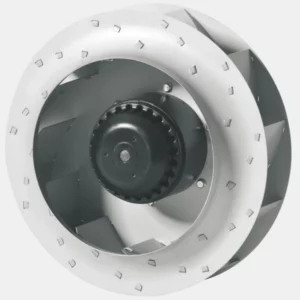High-pressure centrifugal fans are vital components in various industries and applications where there is a need to move air against significant resistance. These fans offer powerful airflow capabilities and are designed to handle demanding environments that require efficient air movement at elevated pressures. In this article, we will explore several types of high-pressure centrifugal fans, comparing their features, advantages, and applications across different industries.
Forward Curved Centrifugal Fans
- Design and Function:
Forward curved centrifugal fans feature blades that curve in the direction of rotation. These fans are characterized by their high airflow capacity and relatively lower static pressure capabilities. They are commonly used in applications that require moderate pressure and high volume air movement, such as HVAC systems, cleanrooms, and air handling units. - Advantages:
- High airflow capacity: Forward curved fans can handle large volumes of air, making them suitable for applications that prioritize air circulation and cooling.
- Low noise levels: The design of forward curved blades reduces noise production, making these fans ideal for noise-sensitive environments.
- Compact size: Forward curved fans are often compact, allowing for easier installation in space-constrained areas.
- Applications:
- HVAC systems
- Cleanrooms
- Air handling units
- Building ventilation
Backward Curved Centrifugal Fans
- Design and Function:
Backward curved centrifugal fans have blades that curve away from the direction of rotation. These fans are known for their high static pressure capabilities and energy efficiency. They are used in applications that require increased pressure to overcome resistance, such as ducted systems, industrial ventilation, and air pollution control systems. - Advantages:
- High static pressure: Backward curved fans can generate substantial pressure, making them suitable for applications that involve pushing air through long ducts or against resistance.
- Energy efficiency: The design of backward curved blades and streamlined airflow paths contribute to improved energy efficiency, reducing operating costs.
- Versatility: Backward curved fans can handle a wide range of airflow volumes and resistances, providing flexibility in various applications.
- Applications:
- HVAC systems
- Industrial ventilation
- Air pollution control systems
- Process cooling and drying
- Dust collection systems
Radial Blade Centrifugal Fans
- Design and Function:
Radial blade centrifugal fans feature straight blades extending radially from the hub. These fans are designed to handle moderate to high static pressures. They offer robust performance and are commonly used in applications that require high-pressure air movement, such as pneumatic conveying systems, air curtains, and spray booths. - Advantages:
- High-pressure capability: Radial blade fans excel in generating high static pressure, making them suitable for applications that require air movement against significant resistance.
- Durability: The robust design of radial blades makes them resistant to wear and damage, ensuring long-term reliability.
- Suitable for high-temperature applications: Radial blade fans can handle elevated temperatures, making them suitable for applications involving hot air or gases.
- Applications:
- Pneumatic conveying systems
- Air curtains
- Spray booths
- Industrial drying systems
Multistage Centrifugal Fans
- Design and Function:
Multistage centrifugal fans consist of multiple fan stages arranged in series. Each stage consists of an impeller and a diffuser. These fans can achieve higher pressures than single-stage fans and are commonly used in high-pressure applications, such as boiler systems, power plants, and industrial processes. - Advantages:
- Extremely high static pressure: Multistage fans can generate exceptionally high pressures, making them suitable for applications that require air movement against extreme resistance.
- Precise pressure control: The multiple stages allow for fine-tuning of pressure levels, ensuring optimal performance in complex systems.
- Efficient energy utilization: Multistage fans can achieve high pressure while maintaining energy efficiency, minimizing wasted energy.
- Applications:
- Boiler systems
- Power plants
- Industrial processes
- High-pressure pneumatic systems
High-pressure centrifugal fans come in various types, high pressure centrifugal fan each with its unique features and advantages. Forward curved fans offer high airflow capacity, while backward curved fans excel in high static pressure applications. Radial blade fans are designed for moderate to high static pressures and are suitable for demanding environments. Multistage fans provide exceptional pressure capabilities for complex systems. Understanding the characteristics and applications of these fan types is crucial for selecting the most suitable option for specific industries, ensuring efficient air movement and optimal performance in high-pressure scenarios.
